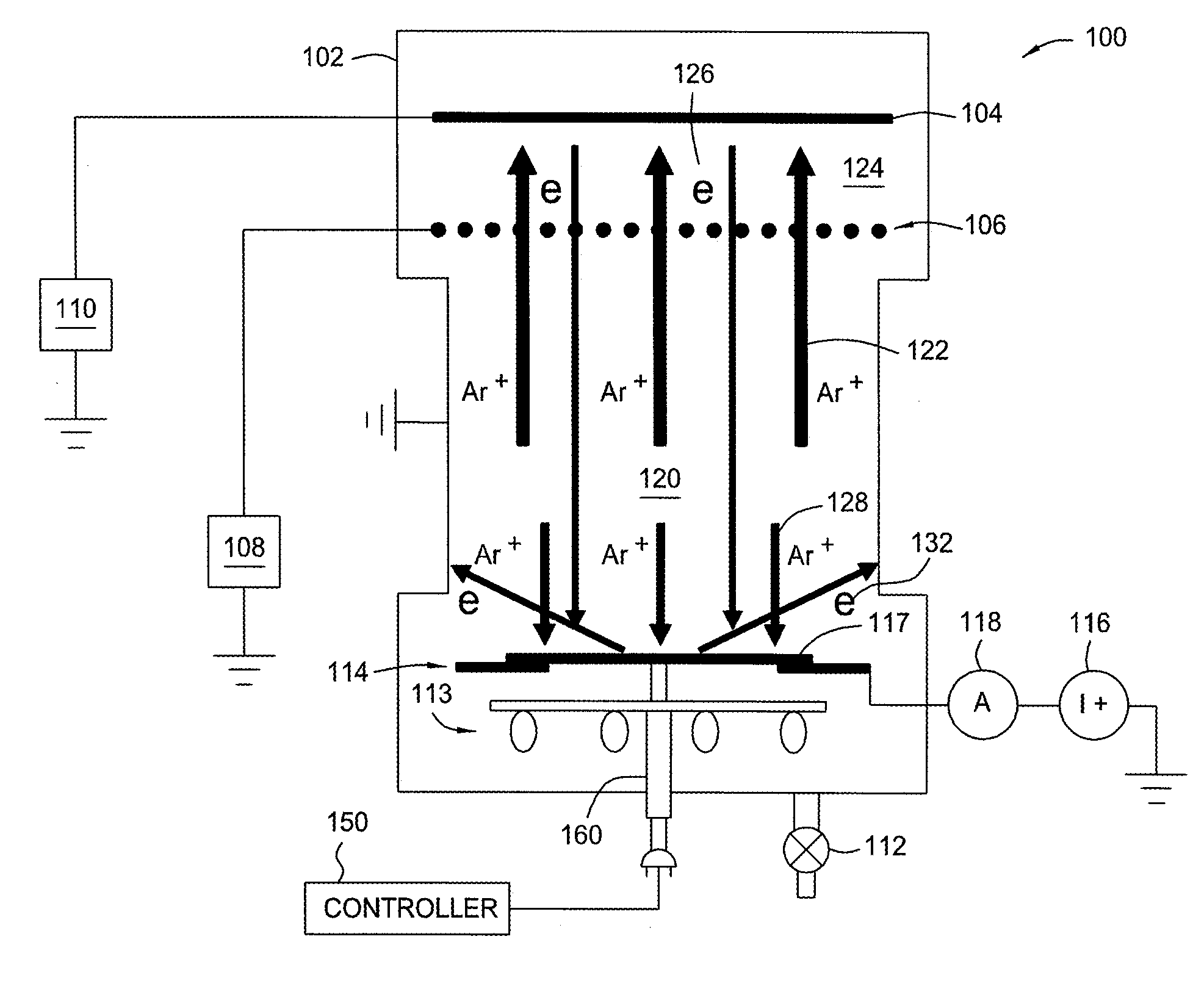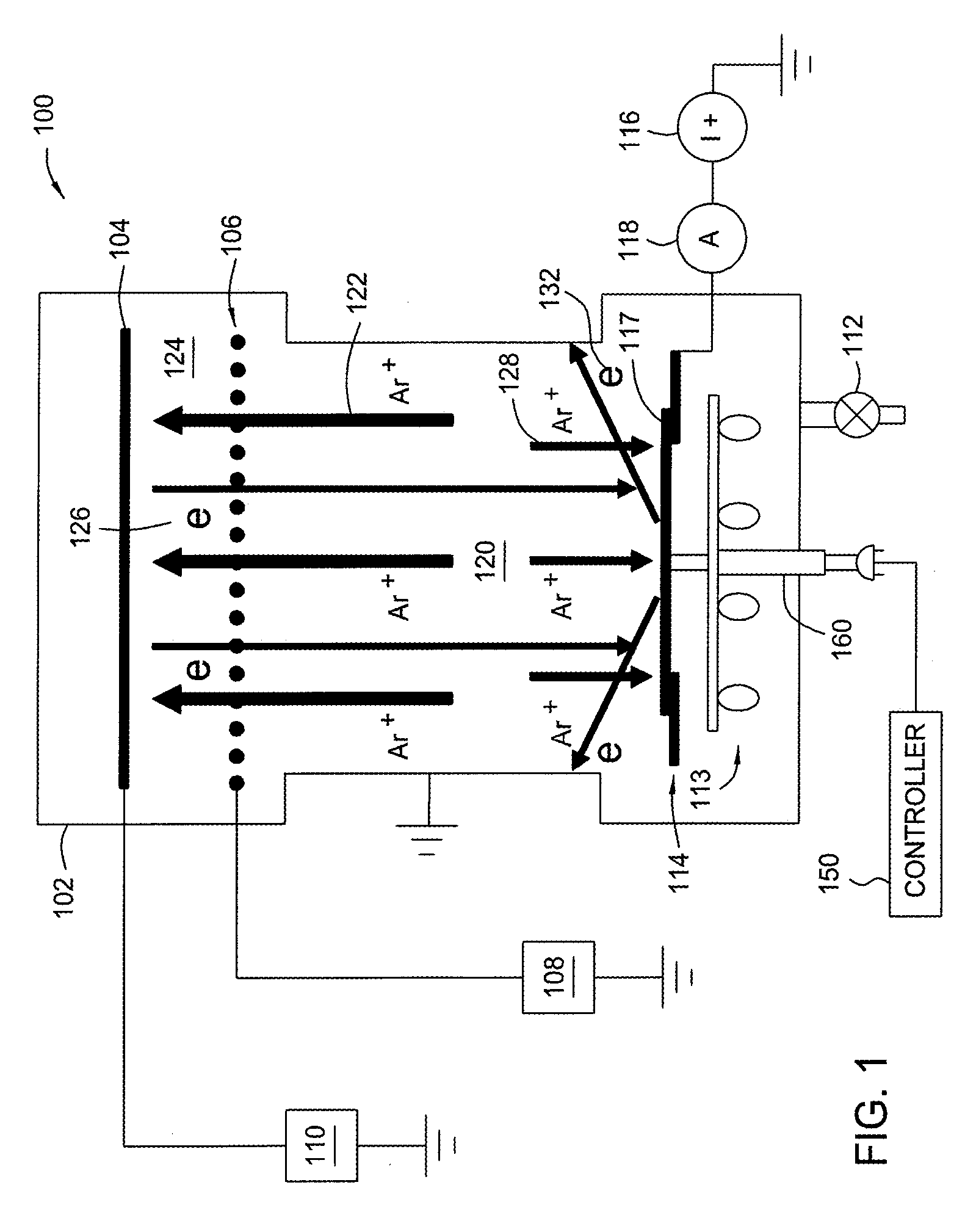Vacuum reaction chamber with x-lamp heater
a technology of vacuum reaction chamber and x-lamp heater, which is applied in the field of vacuum reaction chamber with x-lamp heater, can solve the problems of negative side effects of current electron beam chamber design on a substrate, damage or destruction of semiconductor devices, and the design of current electron beam chamber can have negative side effects on a substrate, so as to reduce the damage to the substrate
- Summary
- Abstract
- Description
- Claims
- Application Information
AI Technical Summary
Benefits of technology
Problems solved by technology
Method used
Image
Examples
example 1
[0058] A bare silicon substrate was electron beam treated an apparatus as shown in FIG. 1 under the following conditions: an electron beam energy of 2 keV, an anode voltage of −125 V, an electron beam current of 1.5 mA, an argon flow of 100 sccm, and a substrate temperature of 353° C. The charge current on the substrate was measured at different substrate DC bias voltages. FIG. 2A is a graph showing the charge current on the substrate at different substrate DC bias voltages.
example 2
[0059] A bare silicon substrate was electron beam treated under the following conditions: an electron beam energy of 3 keV, an anode voltage of −125 V, an electron beam current of 1.5 mA, an argon flow of 100 sccm, and a substrate temperature of 353° C. The charge current on the substrate was measured at different substrate DC bias voltages. FIG. 2B is a graph showing the charge current on the substrate at different substrate DC bias voltages.
[0060]FIG. 2A shows that a substrate charge current of 0 mA or about 0 mA was obtained when a substrate bias voltage of approximately −20 V was applied to the substrate during an electron beam treatment having an energy of 2 keV. FIG. 2B shows that a substrate charge current of 0 mA or about 0 mA was obtained when a substrate bias voltage of approximately −23 V was applied to the substrate during an electron beam treatment having an energy of 3 keV. Thus, FIGS. 2A and 2B illustrate that embodiments of the invention provide a method of producin...
example 3
[0063] Silicon substrates having a film of Black Diamond IIx (process conditions available from Applied Materials, Inc. of Santa Clara, Calif.) deposited thereon were electron beam treated in an apparatus as shown in FIG. 3 under the following conditions: an electron beam energy of 3.3 keV, an anode voltage of −125 V, an electron beam current of 1.5 mA, an argon flow of 100 sccm, and a substrate temperature of 400° C. The grounded aluminum wire grid of the apparatus had 66% transparency, a wire diameter of 10 mils, and 0.011 inch diameter openings. The charge current on the substrates was measured at different grid bias voltages. The charge current on the substrates increased as the grid bias voltage was increased and reached 0 at a grid bias voltage of 25 V. The properties, including thickness, refractive index, shrinkage, thickness uniformity, dielectric constant, and stress, of the Black Diamond IIx films after the electron beam treatments were comparable to the properties of Bla...
PUM
| Property | Measurement | Unit |
|---|---|---|
| charge current | aaaaa | aaaaa |
| bias voltage | aaaaa | aaaaa |
| bias voltage | aaaaa | aaaaa |
Abstract
Description
Claims
Application Information
 Login to View More
Login to View More - R&D
- Intellectual Property
- Life Sciences
- Materials
- Tech Scout
- Unparalleled Data Quality
- Higher Quality Content
- 60% Fewer Hallucinations
Browse by: Latest US Patents, China's latest patents, Technical Efficacy Thesaurus, Application Domain, Technology Topic, Popular Technical Reports.
© 2025 PatSnap. All rights reserved.Legal|Privacy policy|Modern Slavery Act Transparency Statement|Sitemap|About US| Contact US: help@patsnap.com



